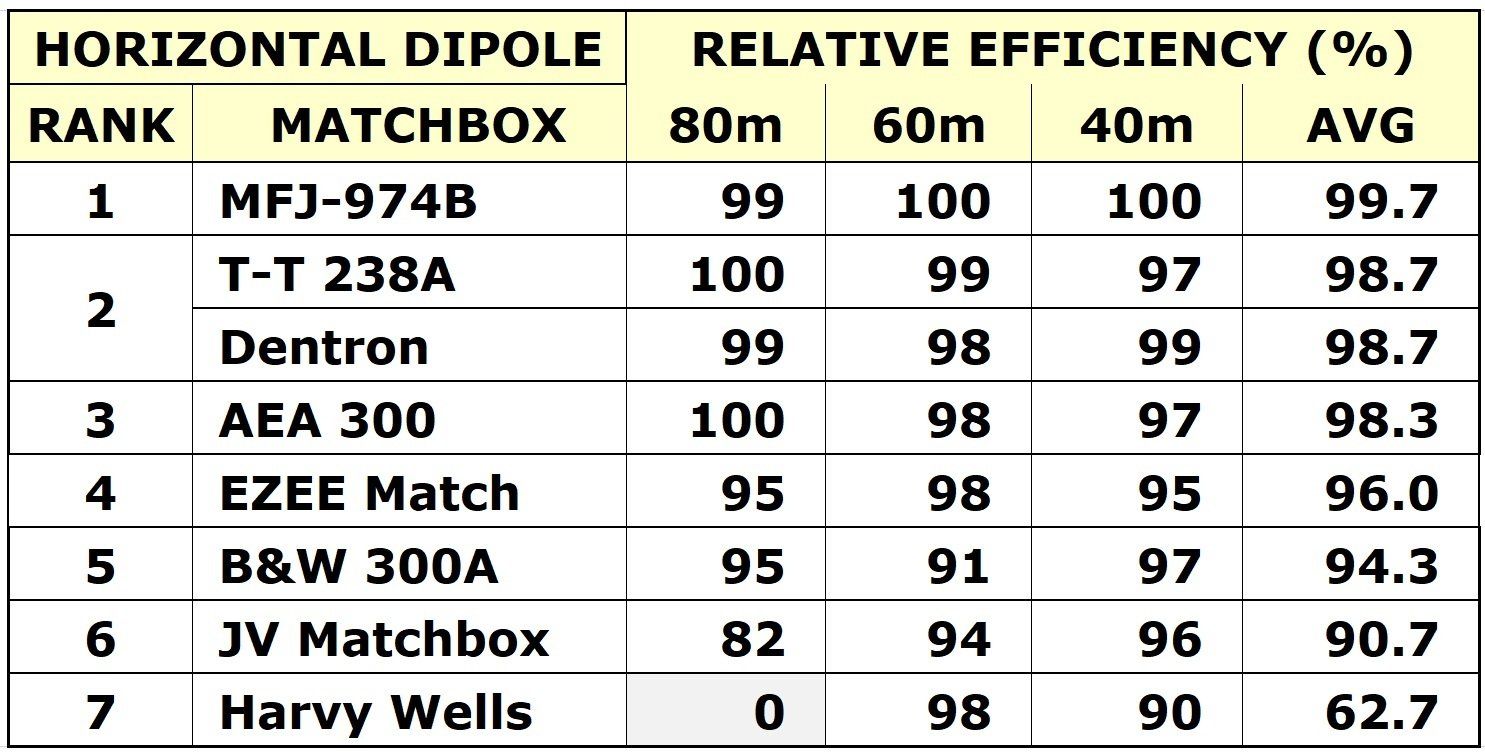HORIZONTAL DIPOLE:
Note: Peter only uses this antenna on 80/60/40m. Thus he only measured it on these three bands.

(Remember: "Matchbox" = "Johnson Viking Matchbox" and "AEA 300 = Ameritron AT-300")

(Efficiency: a higher number is better)

(Unbalance: a lower number is better)
EFFICIENCY:
The first 4 matchboxes are close enough to say there is no difference.
REMEMBER: This is not the total efficiency of each matchbox. It only shows how efficient each matchbox is, compared to the best in the group.
UNBALANCE:
We have no precedence to know how much unbalance it takes to begin to cause trouble. We can assume that an unbalance of less than 2% is good enough. 3% probably is too.
In general, the unbalanced matchboxes using an external balun performed just as well as the symmetrical matchboxes.
COMMENTS:
COMMENTS (KD7KW):
(Note: many viewers may wonder why Peter measured this but didn't measure that. Peter will explain his reasoning in his comments below).
General Comments on the measurements of this antenna:
We probably should say something about why I didn't test all the tuners with a good Medium impedance on 15, 12 and 10m. What happened was that I had finished the main testing and put many of the tuners away before it occurred to me to try the 14 and 16 foot lengths with those bands. At which point I only tested them with the three tuners I knew I was going to keep (TenTec 238A, MFJ 974 and E-Zee Match).
Before I put up the vertical dipole, I had tried the Inverted-Vee on all bands, albeit without loss and CMC measurements. And before that, I had an 80m Inverted-Vee about 60 feet up in a now-deceased tree.
I can tell you a few pertinent things from that experience:
1) The B&W 300a never worked on 10m with any antenna and feedline length I tried.
2) The Dentron Supertuner could achieve a match on 12 and 10m, but it was higher than 1:1, and SWR readings changed slightly when touching the chassis, indicating CMC issues.
3) The AEA AT-300 worked on all bands. Depending on the feedline length and the antenna, there was some CMC, as shown in the "touch the chassis" test. It's actually a very nice tuner, it just has higher losses than the best three if you push it too hard.
4) On 15m and above, all the tuners except the TenTec 238a exhibited odd behavior in at least one band. It appears that stray capacitances, inductances and self-resonances may rear their heads here, even at some "good" impedances.
5) The "Famous" Johnson Viking Matchbox: I was able to get a match on all bands with the JVM on both antennas, with about 32 feet of extra feedline thrown around the shack. In other words, using about 72 feet of feedline with the inverted vee, and 102 feet with the vertical dipole. Interesting, but I'm not going to do that in regular operation. Hams who happen to have a "sweet-spot" length of feedline may think the JVM is still the champ. But most people won't be that lucky.
6) My adding a 300 pf variable capacitor to the JVM's input (as suggested by DJ0IP) entailed shortening the input coil by 1/4 turn and re-routing one lead of the coil. Did this contribute to its less than stellar performance? Maybe, but I don't think so. I was actually able to match more bands with the capacitor than without it.
Adding a switch to the input coil (also suggested by DJ0IP) presented too many mechanical challenges, so I didn't do it.
It would be interesting to fool with one of those bare-bones homebrew link-coupled tuners where you have to adjust clips on both coils to change bands. I suspect you could find good-performing settings for all bands. But who is going to operate like that today?
Alfred Annecke found good settings for the input coil, put them on a bandswitch, and voila!
SUMMARY:
These tests seem to show that ALL tuners perform best in the range of about 30 to 400 ohms. The exact boundaries of this Sweetspot" Zone vary from tuner to tuner. Push them too hard, and they begin to exhibit loss, imbalance and/or CMC in some combination.
The tuner design and its physical construction seem to be the key. The TenTec 238a can handle very low impedances well, but its impedance range gets narrower above 18 MHz, and especially on 28 MHz.
The MFJ 974b is much better than its ARRL review would indicate.
Big boxes with big components seem generally better than small ones with pipsqeaky components like the B&W 300a. Z-match tuners are a pleasure to use, but their performance falls off at impedance extremes, and they are more prone to CMC and imbalance at higher frequencies.
And while the Johnson Viking Matchbox is a beautiful, elegant piece of post-WWII engineering, it simply does not perform as well as more modern designs. Nostalgia ain’t what it used to be.
COMMENTS (DJ0IP):
No matchbox performed best on all bands. The ranking order of the matchboxes on each band was different from the ranking on other bands. The Ten-Tec 238A and MFJ-974 were the two best matchboxes overall with this antenna.
Though a beautiful old matchbox, the Harvey Wells was the worst with this antenna (except on 60m). In fact it could not even find a match (with the length of feedline used) on 80m.
Notice that the antenna matchboxes using an external balun all have at least 95% efficiency, an excellent balance and excellent Common Mode Current rejection - with unbalance and %CMC ≤ 2%.
Clearly there is no significant advantage in using any
of these "Balanced Matchboxes" with this antenna.
Next Page: Vertical-Dipole 40m Results ->
